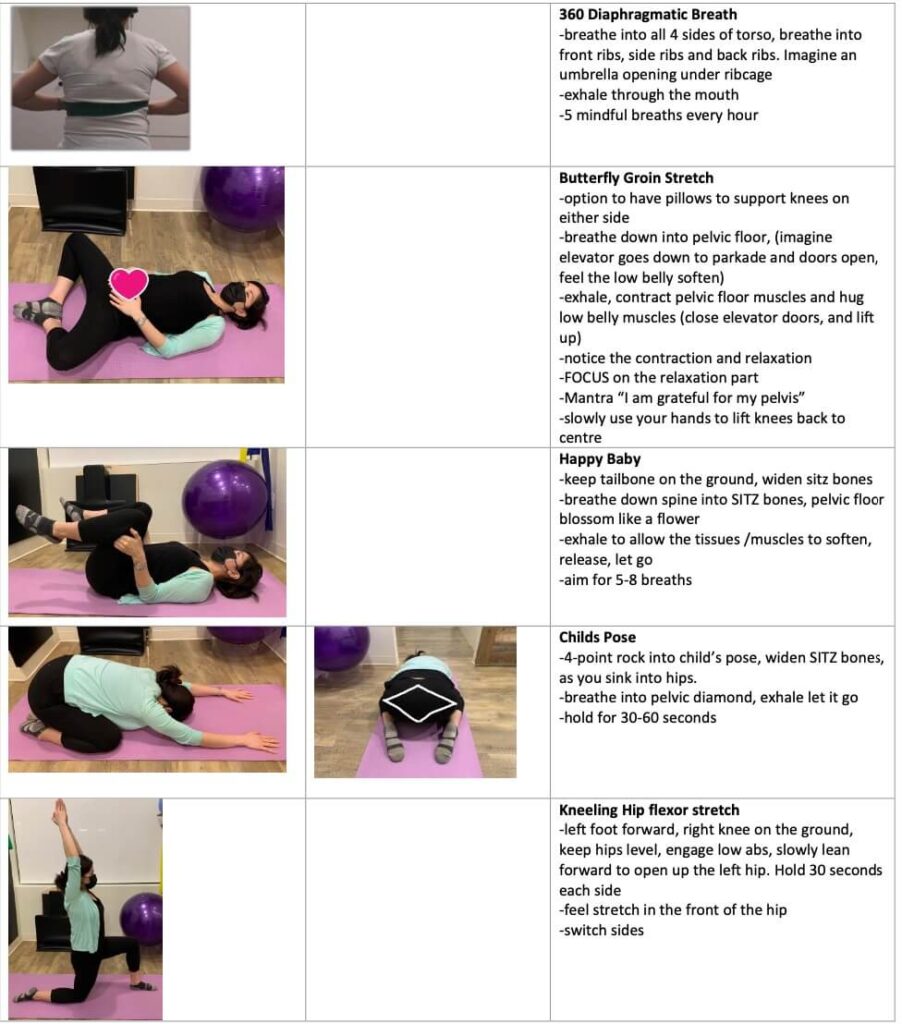Endometriosis and your pelvic health
Did you know that pelvic health physiotherapists can help treat the symptoms of endometriosis? Currently, endometriosis affects 1/10 people with a uterus in Canada and is severely misunderstood, mis or poorly diagnosed and takes a long time to diagnose. The average time from symptom onset to receiving a diagnosis can range from 6-12 years.
In this post, we are going to review what is endometriosis, its signs and symptoms, how the pelvic floor muscles are involved and provide some insights into how pelvic health physiotherapists can help.
What is Endometriosis?
Endometriosis is a condition in which the tissue that normally lines the inside of the uterus (the endometrium) grows outside of the uterus. This can cause inflammation, scarring, and adhesions in the pelvic region, which can lead to pain and other symptoms.
Symptoms of Endometriosis
The symptoms of endometriosis can vary from person to person, but they often include:
- Pelvic pain, especially during menstruation or sex
- Painful bowel movements or urination
- Heavy periods or irregular bleeding
- Infertility or difficulty getting pregnant
- GI and bowel symptoms including bloating, gassiness, cramping, diarrhea, constipation
If you experience any and/ or all of these symptoms, please check in with your primary care medical provider for an assessment.
Endometriosis and your pelvic floor muscles
Did you know that Endometriosis can have a significant impact on your pelvic floor muscles? When the endometrial tissue grows outside of the uterus, it can cause inflammation and scarring in the pelvic region. This can lead to a range of pelvic floor problems, including:
- Pelvic Pain: This pain can be felt in the lower abdomen, pelvis, and lower back, and can be worsened by activities such as sex, exercise, or bowel movements.
- Urinary and Bowel Problems: Individuals might experience pain with urination or bowel movements, or difficulty emptying the bladder or bowels (ie urinary retention or constipation).
- Sexual Dysfunction: Endometriosis can lead to painful or uncomfortable sexual activities including orgasm and pain with receptive intercourse.
- Pelvic Floor Muscle Dysfunction: Ongoing and persistent pain and inflammation in the pelvic region can cause the pelvic floor muscles to become tight or weakened. This can lead to problems such as pelvic floor muscle spasms, urinary or fecal incontinence, pain with sexual activity and generalized pelvic achyness and pressure to suggest a few.
How to manage Endometriosis and associated pelvic health symptoms
Pelvic health physiotherapists are a great resource and can be a helpful ally on your health care team in navigating endo symptoms. Pelvic health physiotherapists are here to support you in providing education, resources, exercises and manual therapies to alleviate pelvic and abdominal pain, improve bladder and bowel function, hands on myofascial release techniques to the abdomen, hips, low back, glutes, pelvic floor and inner thighs to relieve tension, dry needling or IMS techniques, advocate on your behalf for ongoing therapeutic and medical treatments and providing community referrals to other providers who would be a welcomed addition to your care team.
Many individuals diagnosed with endometriosis can benefit from breath work and pelvic floor muscle lengthening activities. If you are feeling tension or pain in your pelvic floor, here are a few suggestions of exercises to try. When in doubt or if you would like a tailored program to you, a registered pelvic health physiotherapist can help!
Breathwork and pelvic floor lengthening exercises for Endometriosis

Pelvic health products to support those living with Endometriosis
There are also a few products that could be helpful in managing symptoms, including period underwear designed for heavy flows, the Ohnut for pain with receptive intercourse, vaginal dilators or a pelvic wand to decrease pelvic floor muscle tone. If you are curious about how any of these products might be able to help you, please consult with a pelvic health physiotherapist prior to incorporating them into your self care routine.
Endometriosis is a challenging condition to diagnose and treat, which can lead to a significant delay in diagnosis and can impact an individual’s physical and mental health and quality of life. Management of endometriosis requires a multi system, integrated and holistic approach. If you are experiencing symptoms of endometriosis, we encourage you to discuss your concerns with a trusted medical provider.
Community connections for individuals living with Endometriosis
If you have been diagnosed with Endometriosis and are looking for community connections and resources, here are a few blogs and social media pages to check out.
- Endometriosis Network Canada– The Endometriosis Network Canada is a non-profit organization that offers education, support, and advocacy for individuals with endometriosis in Canada. Amongst their many resources, they host twice monthly online support group meetings for those living with Endo.
- Endometriosis UK – Endometriosis UK is a charity organization that offers support and information to individuals with endometriosis. Click on “Get support”, for access to an online community, support groups, a help line and more resources.
Instagram pages to follow for connection, information and support!
Questions about Endometriosis and the pelvic floor? Ask us in the comments below.
Lacey Forsyth, MPT
Founder and Registered Physiotherapist at Bump Physio & Co
Bump Physio & Co is a community of health care providers dedicated to changing the way pelvic health and obstetrical services are delivered. Our two clinics locations are Port Moody and Langley BC, where we treat beyond the Bump and welcome clients from all stages and phases of life. Our team has advanced training in Pelvic Health, Orthopedics, Obstetrics, Clinical Pilates, and Active Rehabilitation.
Please follow us along on our socials @bumpphysio.co keep updated on all that is going on and for more information about how the Bump Community can help YOU!
References
Agarwal SK; Chapron C; Giudice LC, Clinical diagnosis of endometriosis: a call to action. American Journal of Obstetrics & Gynecology; 2019: 354-364.
dos Bispo, A.P.S., Ploger, C., Loureiro, A.F. et al. Assessment of pelvic floor muscles in women with deep endometriosis. Arch Gynecol Obstet 294, 519–523 (2016). https://doi.org/10.1007/s00404-016-4025-x
Gehrich AP, Aseff N, Iglesia CB, Fischer JR, Buller JL. Chronic urinary retention and pelvic floor hypertonicity after surgery for endometriosis: A case series.
Orr NL, Noga H, Williams C. Deep Dyspareunia in Endometriosis: Role of the Bladder and Pelvic Floor. J Sex Med 2018;15:1158-1166.
Vilasagar S, Bougie O, Singh SS. A Practical Guide to the Clinical Evaluation of Endometriosis-Associated Pelvic Pain. The Journal of Minimally Invasive Gynaecology. (2020) 27, 270−279.
Websites
http://www.bcwomens.ca/our-services/gynecology/pelvic-pain-endometriosis/
